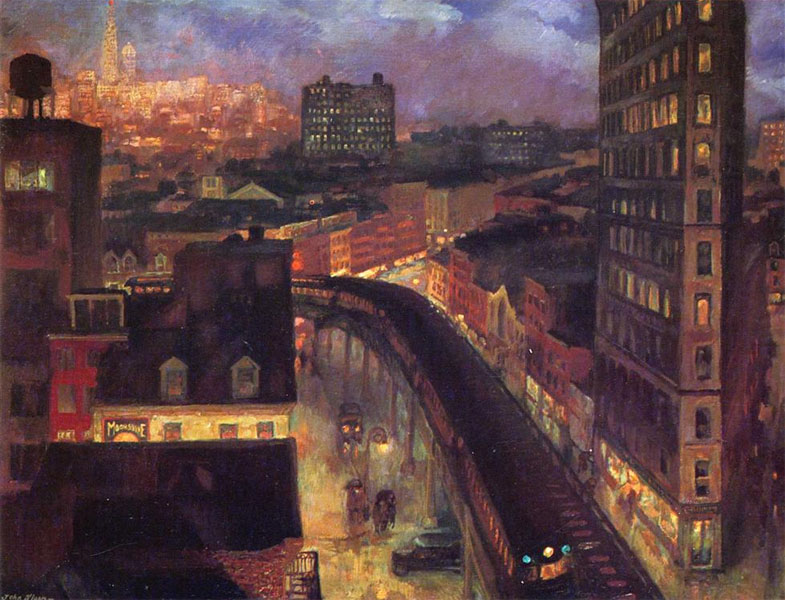| ....and, perhaps
his best known work, "The City from Greenwich Village, 1922":

The City from Greenwich Village
Years later, I, too, would be
walking on the
streets of New York, especially in my native borough, the Bronx, but
instead
of seeing people and objects as an artist would--to know and be just
to--I
would usually be "in myself," hardly noticing what was around me.
In The Right of, #1291, titled "More Life," Aesthetic Realism Chairman of Education Ellen Reiss asks,
Who is more
alive:...a person who
can look at an object, maybe the bare branch of a winter tree, and be
interested
in it, feel that in its humble bareness yet proud diagonal lift it is
beautiful?;
or...a person who looks at the branch yet doesn't really notice it, and
moves on?
Most of the time, I moved on. I
felt the only
thing interesting and exciting were sports, and I often imagined myself
the star with people applauding me, first as a player and later as a
sports
reporter on radio. I felt people who got all worked up about
beauty--flowers,
trees, art of any kind--were just foolish and wasting their time. I
would
scornfully think, "I don't need that, it doesn't put any money in my
pocket."
As a
boy I was constantly
after my father and older brother to take me to Yankee Stadium, The
Polo
Grounds and Madison Square Garden. l didn't know it, but the
reason
I loved sports is explained by the great Aesthetic Realism principle,
"All
beauty is a making one of opposites and the making one of opposites is
what we are going after in ourselves." Sports puts together
opposites
such as mind and body, surface and depth, individuality and
relation.
These opposites were in the greatest hitter I ever saw, the Red Sox'
Ted
Williams, who, along with unique physical ability, carefully studied
the
art of hitting, and then generously wanted to help other players,
including
giving hitting advice to members of opposing teams. I needed to
put
these opposites together in my life--to be deeply interested in other
things
and people as the means of being my individual self.
Not
knowing this,
I went for the pleasure of making less of things, building myself up at
the expense of other people, who, I assumed, I didn't need to be
interested
in or affected by. When I was about 9 or 10 years old and guests came
to
our house, I felt very uncomfortable and often would go to another room
preferring to listen to the radio. When my parents wanted to
visit
relatives or friends, I would make their lives miserable by either
refusing
to go or by finally going reluctantly. I would think, "Who needs
this? I don't want to be with those boring people." While I gave the
appearance
that I was quiet and shy, inside I was a snob, feeling nobody else had
a life really worth thinking about, or that they, in any way, could add
to me. This ugly desire to ward off and lessen others literally made me
less. I felt hollow and lonely and I thought this was how I would
always be.
In one of the first classes I
had the honor
to attend in 1972, taught by Eli Siegel, he asked me:
In the field of
ethics is there anything
compulsory? In the field of art is there anything compulsory?....Is
there
a need to do the best with yourself as you can? Do you think there is
something
that impels one to hope one has had a good effect?
I had no idea such a hope was in
me. Mr. Siegel
then asked:
Do you think you
would feel bad if
you felt you had a bad effect on anyone?
MP. Yes. I think I had a bad
effect on my
parents.
ES. Where do you think you
hurt them?
MP. I could have been
kinder.
ES. Do you like to encourage
people? Do you
think if you failed to encourage people you would feel bad? The chief
thing
we are concerned with is what we might have done that we didn't
do....There
is an imperative to think as well of ourselves as we can.
Studying
what Mr. Siegel
called "the ethical imperative" gave me a new purpose. It changed
the dulling, life-sapping course of my life. Shortly after this class,
I met with my father, who was visiting from Florida, and we had the
first
real conversation we ever had. I actually asked him questions
about his
life, feeling I needed to know and be fair to him. I told him what I
was
learning newly about myself, the regrets I had about my meanness to him
and my mother. As we talked, I saw that I had missed so many
things
about him. He told me about his childhood on the lower east side
and how he saw his father, who had sold second-hand clothes in a cart
to
support his family. We were both very moved, and he was impelled
to write to Mr. Siegel that day, thanking him for the effect Aesthetic
Realism had on my life. He wrote, "I feel this one day added
twenty
years to my life." I feel greatly fortunate for my rich, happy life,
which
includes my marriage to Lynette
Abel,
whose keen, lively seeing of the world, her passion that justice come
to
other people encourages me every day.
continued
on page 2
|